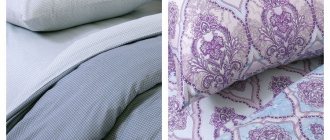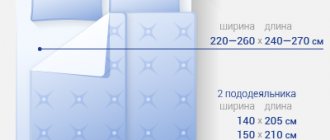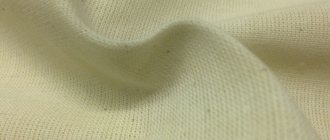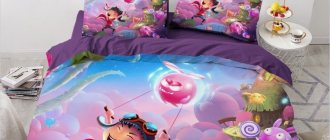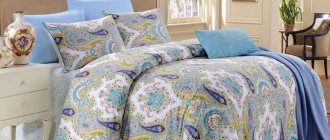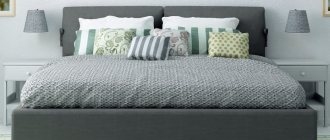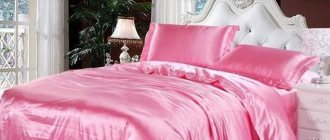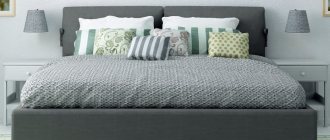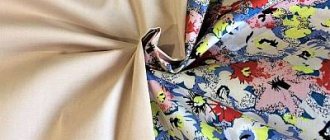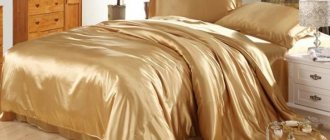Sound sleep is the key to health. In order for the body to fully rest, it is important to choose high-quality bedding. Doctors recommend giving preference to cotton - poplin or calico. They don’t specify which is better. You need to make the choice yourself, based on personal preferences. Poplin is more about an aesthetic appearance and softness, and calico is more about a favorable price and practicality.
What is calico?
Calico fabric is famous for its density, strength and practicality. It is made from 100% cotton, and therefore perfectly absorbs moisture and allows air to pass through. Products made from calico never cause allergies.
Calico is distinguished by high wear resistance, which is achieved due to the dense interweaving of threads of the same thickness in a crosswise manner.
Close-up photo of fabric:
The density of calico varies from 80 to 142 g/sq.m. m. Calico 80 g/sq. m. loose, gauze-like. The higher the density, the better its quality. For bed linen, calico 125 g/m2 is usually used. m. The new fabric is somewhat stiff and rough. But over time, it acquires softness without losing strength.
Interesting fact. Bed linen is made from high-density calico for hotels, medical institutions, and sanatoriums.
Advantages and disadvantages
Today, calico is the main type of fabric for sewing bed linen. The material can withstand “countless” numbers of washes and has many advantages:
- Calico is a natural fabric that does not emit toxic substances, hypoallergenic and environmentally friendly;
- Excellent air permeability, allowing the body to “breathe”.
- Absorbs body secretions well.
- Retains heat in winter and does not cause overheating in summer.
- Practical, low maintenance.
- Has the highest possible safety margin.
- Affordable.
Disadvantages of fabric:
- unassuming appearance;
- coarseness.
Calico is a simple fabric in every sense. She can't be called beautiful. Children and people with delicate skin may find it too rough and harsh. In terms of tactile sensations and appearance, calico is inferior to poplin, satin and many other fabrics.
Features of calico bed linen
Today, harsh (unfinished) and bleached calico are produced for furniture upholstery and workwear. In the production of bed linen, plain-colored (plain) and printed (with a pattern) are used. Calico attracts housewives, first of all, with its durability and composition.
100 percent cotton is an environmentally friendly material that does not cause allergies. Linen made from it is equally pleasant both in winter and in summer: in hot weather, calico perfectly absorbs sweat and allows the body to breathe, in cold weather it quickly warms up from contact and maintains a comfortable temperature for sleeping all night.
Another pleasant point: unlike synthetic and mixed fabrics, calico does not accumulate static electricity. But the quality of a material is usually judged by its density:
- 145 g/m2 is the highest standard
. It provides increased strength and wear resistance. And this kind of calico is traditionally used to make bed linen for sanatoriums and hotels, hospitals and orphanages. It is this material that is quite rightly called “eternal”; it is not afraid of either ironing at high temperatures or numerous washings with aggressive detergents; - 125 g/m2 – medium density calico
. Optimal for home textiles; - below 120 g/m2 is a fabric that is definitely not worth buying bed linen from
. Not only can it stretch out greatly during washing, but the dyes such unfortunate manufacturers use are not durable and of poor quality. Linen can not only fade, but even cause serious allergies.
Normally, calico shrinks slightly after the first wash: about 2-3 centimeters for a double sheet or duvet cover.
What is poplin?
Poplin is a light and soft fabric. Bed linen made from it is pleasantly cool in the summer heat, does not irritate the skin, and is suitable for adults and children. Most often, poplin composition is 100% cotton. Less common is a mixture of cotton fiber with cotton, and cotton with synthetics. But this is not the main feature of the fabric.
Poplin differs from other fabrics in the weave of the threads. The warp threads are thin and dense, and the weft threads are thick and loose. Thanks to this, the canvas has a specific texture, reminiscent of a small scar.
Among other things, poplin is characterized by a matte shine and softness even at high densities. Typically, fabric with a density of 110 g/m2 is used for bed linen. The indicator is relatively low, but the products are highly wear-resistant. Bed linen can withstand a large number of washes, maintaining its original color and strength.
Interesting fact. Initially, 100% silk was used to make poplin. It was used to make clothes for the Pope.
Advantages and disadvantages
Poplin is one of the TOP 5 most popular fabrics for bed linen. Its popularity is due to numerous advantages:
- Poplin practically does not wrinkle. It doesn't have to be ironed.
- Made from natural raw materials.
- Not prone to deformation, retains its shape.
- Easy to wash at 40 degrees.
- Highly durable and wear-resistant.
- Absorbs sweat well.
- Allows the body to breathe.
- Soft.
- Comfortable in winter and summer. Has excellent thermoregulating properties.
Natural poplin has no obvious disadvantages. Some may not like the lack of smoothness of the canvas. Some types of poplin underwear (especially thick 100% cotton) can irritate overly sensitive skin.
Disadvantages are typical for poplin made of synthetic cotton. It can roll, shed, and become electrified.
What is the difference between calico and poplin bed linen?
In this section you can find answers to your questions about how calico bed linen differs from poplin.
Calico
A popular and sought-after fabric that is used for sewing PBC. It is inexpensive, but has high quality and is very durable. Calico is a cotton fabric that has a canvas-like texture. The roots of calico cotton fibers begin in the 14th century. The production process was first established with Asian countries, then this fabric began to be calmly transported from one corner to another. The production of fabric began, it was used for linings for uniforms, and only then they began to sew ammunition for military personnel. XVII century - calico found its purpose, now to this day you can find it, namely in the manufacture of bed linen.
This fabric is combined with cotton, which has a special weave of threads and therefore you can buy a 1.5-bed set of bed linen in any store. It has several divisions, such as:
- Severe is a dense and rigid fabric that has low cost and dense texture. It is perfectly used on the farm. It can be of two shades, cream and greenish. The weave is cross, which forms a double-sided fabric. Due to this, it has high wearability. It is taken as a basis for printed and bleached calico. Severe calico is used as the basis for sewing bags, mittens, special clothing, material for mattresses, as well as covers for travel equipment.
- Printed - has a pattern that is applied in a special way. It has three types of patterns: ground pattern, semi-ground pattern and white ground pattern. It is used for sewing robes, kitchen and bedding items, light dresses for adults and children.
- Bleached - it is used when sewing PBC. She has two faces, i.e. bilateral. The basis is harsh calico, which undergoes a special bleaching procedure. All paints and additional substances are completely harmless to humans, so this fabric is perfect for little ones. After it is processed, upon tactile perception, it is soft and pleasant to the touch. Durable and wear-resistant.
- Smoothly dyed - it is used when sewing coats and suits for lining. Low-cost tablecloths, tablecloths, and napkins are produced from this material. The paint is only natural. Plain dyed differs from printed fabric in that the fabric is filled with a single color dye.
There are several types of calico:
- Ranfors.
- Luxury
- Standard.
- Comfort.
- Light.
The European version of the bedding set may be called "RANFORS". This material is not classified as this type of fabric, although it consists of one hundred percent cotton. The density of the material can be achieved by increasing the number of fibers. One sq. meter = 57 threads, but the fabric is incredibly soft and pleasant to the body.
"LUX" - does not have pills that may appear on other types of fabric. The fibers are one and a half times thinner, but have a very soft and delicate texture.
“STANDARD”, “COMFORT”, “LITE” - have different densities, 125/110/120 grams per square meter. They are great for sewing PBC and clothes for adults, as well as children.
Calico is a favorite material for housewives, so it has many advantages, such as:
- durable and wear-resistant;
- reasonable cost;
- natural origin;
- easy to care for;
- accessible;
- washable;
- does not lose its colors and shapes;
- irons perfectly;
- withstands a large number of washes;
- perfectly absorbs moisture;
- breathable;
- comfortable sleep due to its thermal functions;
- not electrified;
- has a flora that is not suitable for the proliferation of bed bacteria;
- does not cause allergic reactions;
- Due to its density, the fabric is very soft and delicate.
The disadvantages include:
- due to natural dyes, the pattern is not very bright in tone and not very saturated;
- with prolonged use, pellets can be detected;
- Over-dried laundry is difficult to iron, so you need to use steam while ironing.
Caring for calico is not so difficult, but if you want long-term use, you should follow some rules. These rules include:
- the new PBC must be washed and ironed well;
- calico must be washed at 40 degrees Celsius;
- ironing on damp laundry;
- Before putting the laundry into the machine, you need to turn it inside out;
- cannot be washed with other materials;
- do not use bleaches or other harmful substances for the material during washing;
- pay attention to the information on the label.
Poplin
When poplin material is produced, fibers of both natural and artificial origin can be used. But when a set of linen is made, cotton is used as the base, so many people argue about what density of satin is better for bed linen , and what are the differences between these two materials. The fabric is made from plain weave. It is very soft and light. Poplin began in the 15th century. Initially it was a very expensive material. Its base is made of silk and wool threads. It was used in church activities. Then they began to sew various clothes from it for going out. Poplin appeared in Russia in the 18th century and some changes occurred in its composition and scope of use.
Poplin has several types:
- Printed - designs are applied by special machines that print on the surface of the canvas.
- Variegated woven is multi-colored fibers intertwined, so we can get striped or checkered patterns.
- Bleached - the fiber contains a special chemical additive. At the end we get snow-white fabric by mixing two colors, green and yellow.
- Smooth dyed is the final stage, after the material has achieved a snow-white appearance, dye is applied to the fabric.
The benefits include:
- durable;
- easy to care for;
- does not wrinkle;
- easy to paint;
- breathable;
- excellent moisture retention;
- very soft fabric;
- dries quickly;
- environmentally friendly material;
- hypoallergenic;
- can be used at any time of the year, i.e. in hot weather it cools, and in cold weather it warms;
- holds its shape perfectly.
The disadvantages include:
- after washing it shrinks by about 10% of the main size;
- expensive in cost.
Caring for such fabric is not so difficult, and even more so, you can learn how to properly wash poplin bed linen, the main thing is to adhere to these rules and it will serve you for quite a long time:
- it is necessary to wash the kpb at forty degrees;
- you need to iron it very carefully, since it does not tolerate high temperatures;
- cannot be combined with other materials during erasing;
- We fill the washing machine only halfway, no more;
- after the product has been washed, it must be laid out or hung along its entire length;
- Pay attention to the information indicated on the tag.
Poplin material does not require special attention to care. It is lightweight but has a strong base, so it always remains unchanged in its appearance.
What is the difference?
The differences between calico and poplin are visible to the naked eye:
- Calico is denser, rougher. It wrinkles easily. Poplin is softer and lighter, and practically does not wrinkle when compressed.
- Poplin has a matte sheen. Calico has a simpler appearance.
- Upon closer examination, you will notice that the warp and weft threads in calico are the same thickness, while in poplin the weft is 1.5-2 times thicker than the warp.
Calico is always made of cotton, and poplin can have a mixed composition. There are many differences between them. To compare the characteristics, we suggest using the table.
comparison table
The difference between poplin and calico is described in detail in the table.
| Calico | Poplin | |
| Naturalness | Yes | Not always |
| Compound | 100% cotton | 100% cotton, cotton with polyester, cotton with silk in different ratios |
| Weave type | Plain, criss-cross, threads of equal thickness | Linen, weft threads are 2 times thicker than the warp |
| Density | 80-142 g/m² | 115 g/m² |
| Strength | High | Above average |
| Hygroscopicity | High | High |
| Breathable properties | High | High |
| Wrinkleability | Yes | Low |
| Colors | Simple, muted colors | Any, bright, saturated colors |
| Shine | Absent | Matte shine |
| Life time | Up to 500 washes | 300 washes |
| Care | Wash at 40-60 degrees, spin up to 800 rpm, iron in “Cotton” mode | As simple as possible. Wash at 40 degrees, spin 800 rpm. Does not require ironing |
| Price (for 1.5 sets of bed linen) | 1700 rub. | 1900 rub. |
| Main advantage | Wear resistance | Combination of high strength with softness |
| Main disadvantage | Roughness, roughness | May contain synthetics |
Fabric differences
For the most part, for ordinary people, the difference between calico, satin and polyline will be noticeable only upon closer examination, and what is even more likely - only by touch. At the same time, it is hardly possible to choose the best one based on such sensations - therefore, the choice will be rather subjective and will only reflect the personal preference of a particular consumer.
If you make an objective comparison, you need to be based on the following characteristics:
| Textile | Ironing | Wash | Feelings from contact | Market price |
| Calico. | Irons well at high temperatures. | Washable in any mode. | The fabric is pleasant, but may seem rough for sensitive skin. | Low. |
| Satin. | It withstands high temperatures well and is easy to iron. | Can be washed in hot water. | Excellent tactile sensation. | Quite tall. |
| Poplin. | Due to its low density, it requires careful ironing. | Requires washing on a gentle cycle. | Very soft and light fabric, pleasant to the touch. | Available. |
Which is better to choose?
From all of the above we can conclude:
- Calico bed linen is a practical option for every day. This set is worth choosing for those for whom sophistication is not important. It is ideally suited for a dacha, a country house, or an apartment for rent.
- Poplin costs a little more than calico, but it also looks more noble. It is usually chosen by those for whom aesthetics and practicality are equally important. In addition, poplin bedding is gentler and better suited for children and people with sensitive skin.
When comparing poplin with calico, it is also important to take into account that bed linen from different companies may differ in quality.
Reviews
Bed linen made of calico and poplin has hundreds of reviews, and all of them are mostly positive. Negative comments are usually left for low-quality sets made from fabric with a large percentage of synthetics. They become covered with pellets, shed, and quickly tear.
Calico bed linen
Bedding sets made from calico are known to be the most durable and natural. Customer reviews.
Veronica:
“I can’t stand synthetics in clothes, and even more so in bed linen. I only buy calico sets. They are strong, one might say eternal, made of 1000% cotton. I like Ivanovskaya (thinner) and Shuiskaya (thicker) calico the most.”
Alexandra:
“I love calico more than any other material in bedding sets. For me it is the most comfortable. The body breathes, does not sweat, there are colors for every taste.”
Elena:
“My mother always bought bedding sets made of calico. At first I didn’t recognize calico. When I was young, I tried other fabrics: satin, satin. But I quickly became disappointed. The quality of calico has no equal. Yes, it is not so impressive (although there are more colors now than before). But it lasts for many years, and is very comfortable for sleeping.”
Alexei:
“A couple of years ago I stupidly bought “Shuiskaya calico” for 460 rubles. Frankly synthetic. Thin, creaky, rolls up, and also stains heavily. This morning I woke up green, like Shrek. Don't repeat my mistakes. Even on sale, calico cannot be so cheap.”
The glory of calico is often used by passing off synthetic fabrics as it. You need to be careful when purchasing, choose kits from well-known companies that have a quality certificate.
Poplin bed linen
Reviews of poplin bed linen often highlight its practicality and pleasant tactile sensations during sleep. Negativity also occurs, but rarely. It is usually associated with marriage.
- Arina: “I like poplin bed linen. The material is good, dense, comfortable. When washed with conditioner, it does not need to be ironed. The first such set was given by a friend. (Ivanovo). I have never seen better quality. The box contained a certificate and fabric samples.”
- Olga Alekseevna: “I have quite sensitive skin. I can’t sleep on bedding mixed with synthetics, but calico is too rough for me. Their satin sets are ideal, but they are too expensive. I recently decided to try poplin bed linen from the famous. The fabric is nice and looks good. The only thing that confused me was the color. It's darker than in the photo."
- Anna: “Last year I bought a set of poplin bed linen from. I got it on sale for 899 rubles. For such a price the quality is not bad. After 7 months the set has not faded and is just as dense. Only during the first wash did it stain the water a little. I also found a small defect in the drawing. Otherwise there are no complaints."
Features of poplin bed linen
In addition to domestically produced fabrics, Russian factories use poplin from Turkey, Pakistan and Indonesia in sewing linen. It can be embossed and smoother, bleached and plain-dyed, variegated (stripe or checkered pattern) and even printed. At the same time, the fabric is always comparable in its quality characteristics, so there is no point in tracking the country of origin.
But you must carefully read the label when buying poplin bed linen: despite the fact that the fabric is classified as natural, its composition can be different. The base is almost always cotton, and synthetic threads, silk, viscose and even wool are used as minimal but still foreign additives.
Depending on the composition, the characteristics of bed linen will vary:
- poplin with wool
is more suitable for winter: the fabric heats up faster and retains the warmth of the human body all night; - poplin with viscose or silk thread
, on the contrary, “cools”, and lying on such sheets in the summer is a pleasure; - the addition of polyester threads
eliminates shrinkage during washing and makes the material more wear-resistant. At the same time, synthetics in the composition always tend to form pellets. Static electricity will also manifest itself, a little, but the hygroscopicity will deteriorate.
Regardless of the composition, poplin is always pleasant to the touch and does not wrinkle as much as calico. Because of this, it can be safely recommended to those housewives who want to simplify their lives as much as possible: ironing a set of poplin bed linen is not at all necessary.
Questions and answers
How to choose quality bedding?
The first thing that should alert you is that the price of the bedding set is too low. High-quality bed linen costs from 1000 rubles and above. It should not have a chemical smell. The lines should be even, without protruding threads. It is better to buy kits from trusted companies with a good reputation and positive reviews.
What is better for sewing bed linen yourself, poplin or calico?
Both fabrics are easy to cut and sew. They behave approximately the same - they do not crumble, do not stretch. The price of fabric is not much different. You just need to take into account that poplin and calico shrink. Bed linen should be sewn with a margin of 6 cm, or the fabric should be pre-washed in warm water.
Among all types of cotton fabrics, calico and poplin remain the most popular. Both fabrics are practical and affordable. Therefore, people often cannot decide which is better, poplin or calico. This question cannot be answered unambiguously. If you need a comfortable, beautiful and lightweight set, then you should choose poplin. If it is important that the bed linen lasts as long as possible, and at the same time the roughness of the material does not bother you, then you can safely buy calico.
Advantages and disadvantages of poplin and calico
Despite their differences, both poplin and calico have a number of common advantages. These include:
- ability to absorb excess moisture (hygroscopicity);
- hygiene;
- environmental friendliness (if the material is made without the addition of chemical fibers);
- hypoallergenic.
However, both types of fabric have their own characteristics.
Outdoor curtains for gazebos and verandas are also sometimes made from calico or poplin.
Men's dressing gowns are made from both cotton and synthetic fabrics.
Reviews of Japanese curtains: .
Poplin
Advantages:
- Variability . When producing this type of fabric, it is possible to combine different raw materials (cotton, silk, wool, polyester). This allows you to change some properties and textile characteristics of the material.
- Low creasing . In order not to make significant efforts when ironing the finished product (or not to iron it at all), just shake it and gently straighten it before drying.
- Air permeability . The fabric allows air to pass through well while retaining heat.
- Softness . The material is quite pleasant to the touch, especially in comparison with calico.
- Sophistication . This advantage should also be considered when compared with calico. The structural features of poplin fabric give it a slightly greater smoothness and sophistication.
- Cost (relative) . In terms of cost, poplin is somewhat more expensive than calico, but the ratio of price and performance characteristics is quite optimal and quite acceptable. Prices for poplin fabric can be found here.
The disadvantages of this type of canvas include:
- Shrinkage . Due to the fact that poplin is a more delicate fabric than calico, there is a possibility of the fabric shrinking if not properly cared for. More often this applies to fabrics made from a mixture of wool and silk.
- Cost (absolute) . Despite the obvious advantages of the fabric, the price of poplin is higher than the price of calico. If you need a low-budget option, then calico remains a priority.
- Wear resistance . Despite the fact that these fabrics are similar in wear resistance, poplin is less durable and wear-resistant.
Calico
You can get acquainted with the characteristics of calico fabric by following the link. The advantages include:
- Practicality . The fabric can withstand multiple washes. With proper care, it does not deform for a very long time and does not lose its color brightness.
- Ability to retain heat . Dense fabric is able to retain and retain heat, which is very important in mid-latitudes.
- Low cost . Calico belongs to fabrics of an affordable price category. And the durability and wear resistance of products made from it make their purchase especially profitable.
What robes and shirts for pregnant and nursing mothers are considered the best?
See photos of curtains with eyelets in the living room.
Reviews about pillow fillers: .
The main disadvantage of calico is its tactile characteristics:
- rigidity;
- roughness;
- simplicity.
